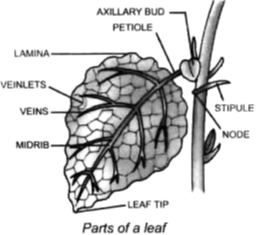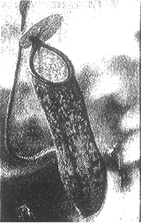- Books Name
- CBSE Class 6 Science Book
- Publication
- Param Publication
- Course
- CBSE Class 6
- Subject
- Science
Leaf
• The following parts of a leaf :
(i) Petiole : The parts of a leaf by which it is attached to the stem is called petiole.
(ii) Lamina : The broad green part of the leaf is called lamina
(iii) Veins : Lines on the leaf are called veins.
(iv) Midrib : A thick vein in the middle of the leaf called the midrib.
(v) Leaf venation : The design made by veins in a leaf is called the leaf venation. It is mainly two types :
(a) Reticulate venation : If leaf design made by veins in a leaf is net like on both sides of midrib the venation called Reticulate.e.g. Leaves of Mango, Pea etc.
(b) Parallel venation : If veins are parallel to one another in a leaf then venation called parallel venation. e.g. leaves of grass.

Functions of Leaf :
1. Manufacturing of Food : The leaf is called “the food factory” of a plant . Green plants make their own food by the process of photosynthesis.Leaves prepare their food in the presence of sunlight and green coloured substance (chlorophyll) present in them by utilizing carbondioxide and water by releasing oxygen.
2. Transpiration : The excess of water absorbed by the root hairs lost through the stomata.Process through which water comes out of leaves in the form of vapour.
Plants release a lot of water into the air through this process.
3. Gaseous exchange : Exchange of gases occurs during respiration and photosynthesis.
4. Vegetative propagation : In some plants, leaves bear buds in the marginal notches from which new plants grow and develop. eg. Bryophyllum, Begonia.
5. Leaves reduced to spines in a cactus plant. In a xerophytic plant, this modification helps to reduce water loss from the plant body.
Stem is fleshy and green in a cactus plant. Stem takes over the function of leaves as the leaves are reduced to spines.
Types of Leaf
• Simple and compound leaves :
(i) A simple leaf is one that consist of a single lamina, which is not divided into segments. Plants like mango, guava and money plant have simple leaves.
(ii) A compound leaf is one in which the lamina is divided into several small segments or leaflet each attached to the same petiole. The leaflet may be arranged on opposite sides of the petiole like in rose and neem or may arise from a common point at the petiole like in palm leaves.
Arrangement of Leaf
Leaves can be arranged along the stem in different ways.
(i) Alternate arrangement : In some plant, a single leaf grows from each point e.g. Mango, sunflower and mustard.
(ii) Opposite arrangement : In some plants two leaves grow opposite to each other from the same node. e.g. Guava and Tulsi.
(iii) Whorled arrangement : In some plans, three or more leaves grow from the same node.e.g. nerium and asparagus.
Modification of the Leaf
(i) Leaf tendrils : In plants like pea and sweet pea leaves are modified into long, slender, coiled structures called tendrils.
• These are used by the plants for climbing.
• Leaves are fully or partly modified to help the plant climb and support.
(ii) Leaf spines : In cacti and plants such as pineapple the leaves are modified into spines that are sharp, pointed structures.
• These structure protect the plant from grazing animals.
• In dry area, the leaves are reduced to spines to prevent loss of water by transpiration.
(iii) Leaves modified to eat insects : In some insectivorous plants, the leaves are modified into pitcher or bladder like structures to trap, hold and digest insect and small animals.
• These trapped insect are digested within these structures and serve as a source of nitrogen to the plant.

Pitcher plant

 PathSet Publications
PathSet Publications
 Param Publication
Param Publication
